#elkin editions
Text




Chris Elkins
5K notes
·
View notes
Text
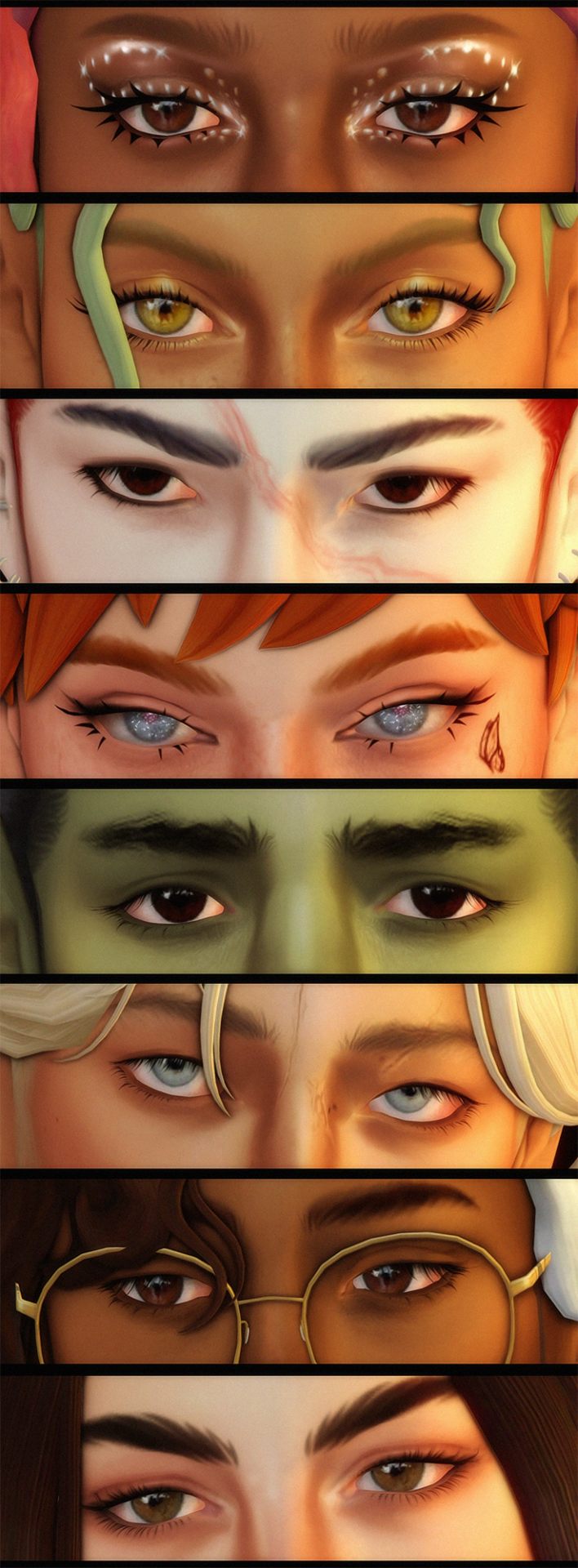
zoomed in on my babies 🪄
inspo is this iconic @ghostputty edit ofc, and also this take on it by @stinkrascal 💞
#ts4 edit#sims 4 edit#ts4#sims 4#my sims#wm: supernatural save#sim: juniper burch#sim: merinda hemlock#sim: xavier thornton#sim: weaver marsh#sim: desmond fell#sim: julian greenwood#sim: frankie burrows#sim: delta elkins#wm: ts4
289 notes
·
View notes
Photo

Elkin Bottle
Artist: Quinton Hoover
TCG Player Link
Scryfall Link
EDHREC Link
19 notes
·
View notes
Text

Yiddish writers, Warsaw, 1922
From left to right, with short biographies:
Esther (Esye) Elkin (?–?) was the wife of Mendl Elkin.
Mendl Elkin (1874–1962) was born to a family of Jewish farmers in Belarus. Though working as a dentist for six years, he was more interested in arts and culture, and would spend his spare time writing for socialist newspapers and acting in an amateur Russian-Yiddish theatre group. He spent the 1910s–1920s between Bobruisk and Siberia before moving to Vilna and founding a theatre group, as well as editing literary journals and writing poetry. He would later move to New York, where he served as Chief Librarian for YIVO.
Peretz Hirschbein (1880–1948) was born near Grodno; his father operated a water mill. He studied at a yeshiva before becoming a Hebrew teacher. In his 20s he began to write poetry and plays in both Hebrew and Yiddish, and would soon move to Odessa to stage his plays. After his theatre troupe disbanded in 1910, he spent the remainder of his life travelling, finally moving with his wife Esther Shumiatcher to Los Angeles.
Uri Zvi Grinberg (1896–1981) was a Yiddish writer before moving into Hebrew. Born into a Hasidic family in what is today Ukraine, he served in the Austro-Hungarian army. Radicalized by the November 1918 pogrom in Lwów, he spent the interwar period between Palestine and Europe. He co-founded the self-proclaimed fascist group Brit HaBirionim and later served as a Member of Knesset for Herut. He was awarded the Bialik Prize three times, as well as the Israel Prize for his contributions to literature.
Khane Kacyzne (?–?) was the wife of Alter Kacyzne. Together they had a daughter, Shulamith, who survived the Holocaust by hiding as a non-Jew. Khane was murdered at Bełżec.
Alter Kacyzne (1885–1941) was a prolific photographer and writer, born to a bricklayer and a seamstress in Vilna. He took up photography early, at age 14, by which point he had also taught himself Hebrew, Polish, German, Russian, and French (alongside his native Yiddish) and had begun to write poetry. Through the interwar period he worked as a photojournalist, travelling extensively, as well as serving as editor for several literary magazines and writing for communist newspapers. He was beaten to death by Ukrainian fascists in 1941, and his wife Khane was murdered at Bełżec extermination camp.
Esther Shumiatcher (1896–1985) was born in Grodno, though her family emigrated to Alberta, Canada in 1911. Interested in poetry and screenwriting, she worked several jobs to make money: as a waitress, in a meat-packing plant, and helping her family run a boarding house out of their home. In the 1920s she went to Warsaw and worked extensively as a poet; her poem "Albatros" gave its name to a modernist Yiddish journal. She was married to Peretz Hirschbein, whom she met while he was taken ill in Calgary and nursed back to health in her family's home. After her husband's death in 1948, she moved to New York.
From the YIVO Archives.
#yiddish#yidishkeyt#jewish#jewish history#uri zvi greenberg#uri zvi grinberg#esther shumiatcher#peretz hirschbein#perets hirshbeyn#alter kacyzne#khane kacyzne#mendl elkin#esther elkin#1922#jumblr
65 notes
·
View notes
Photo


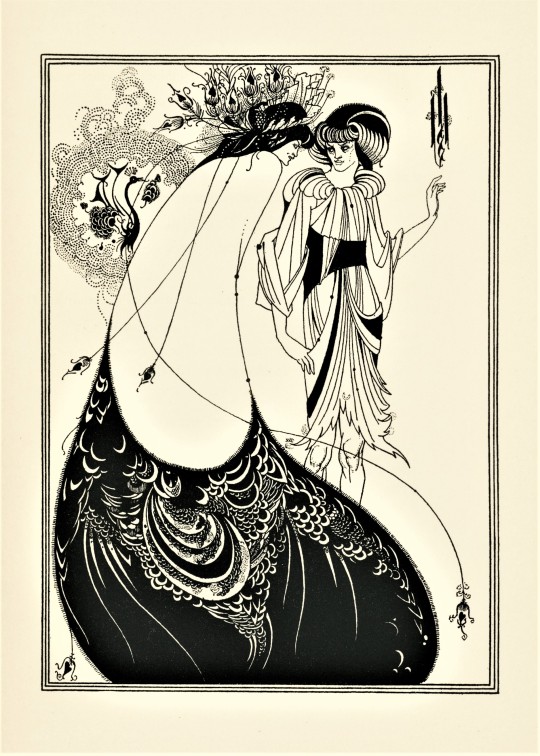
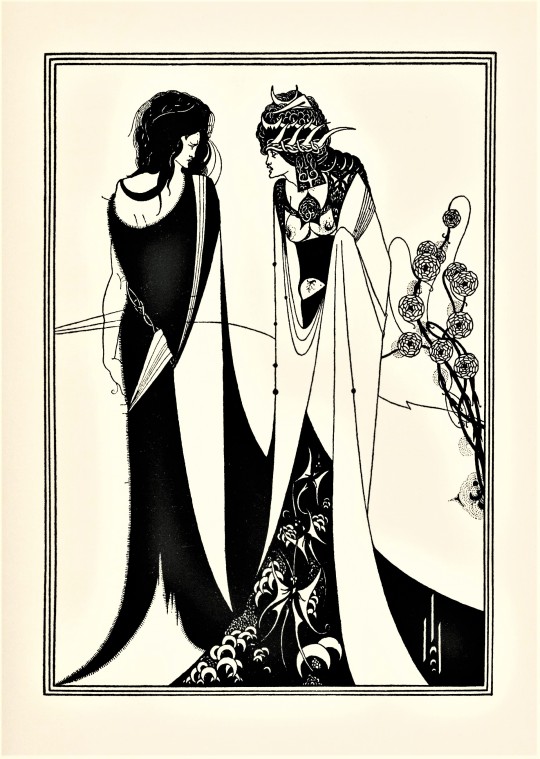


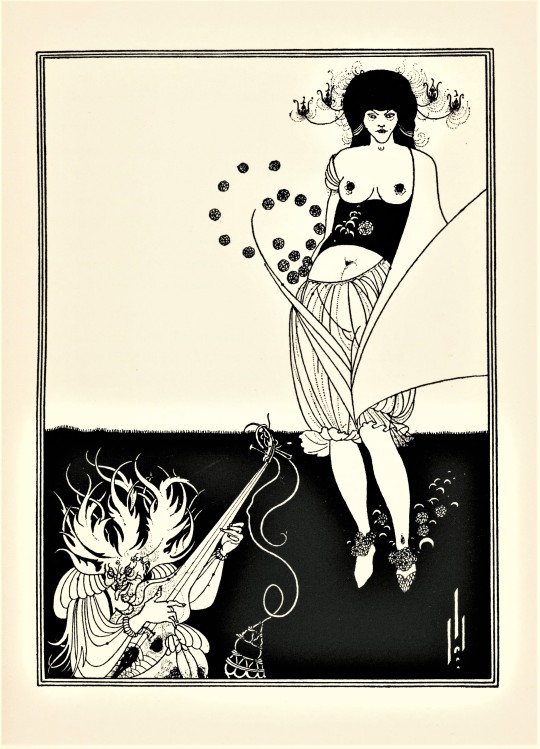


Staff Pick of the Week, Part Two!
Here we continue our look at the 1938 two-volume edition of Oscar Wilde’s one-act play, Salome, published by the Limited Editions Club in an edition of 1,500. Catch up on Part One here.
The English-language volume was printed at The Fanfare Press in London under the direction of Ernest Ingram. Illustrations for the English volume are by Aubrey Beardsley, reproduced from the First English Edition (London: Elkin Mathews and John Lane, 1894). Aubrey had produced sixteen drawings to accompany Wilde’s play, but John Lane had omitted four of them from the original publication and had expurgated two more. It was learning about these additional Beardsley illustrations, as well as Wilde’s lukewarm feelings for the English translation, that sparked the idea to produce two volumes for the work. The Limited Editions Club was able to obtain clear reproductions of Beardsley’s original drawings and included all sixteen (unedited!) in their edition.
Ingram selected Bembo type “because of its crisp design, which harmonizes with the pen line in the Beardsley drawings; and because if its rich black color, which harmonizes with the rich blackness of the Beardsley drawings.” It is the same type used in the Limited Editions Club/Yale University Press edition of W. Somerset Maugham’s Of Human Bondage that we just posted about last week. It is printed on a cream-colored, mould-made rag paper created for the production of this volume in Holland.
Compare Ingram’s design work on the English volume to René Ben Sussan’s choices for the French volume:
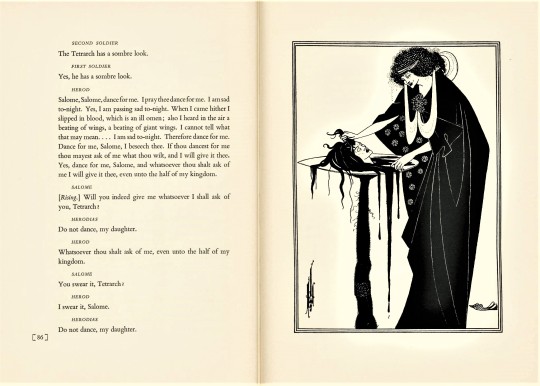
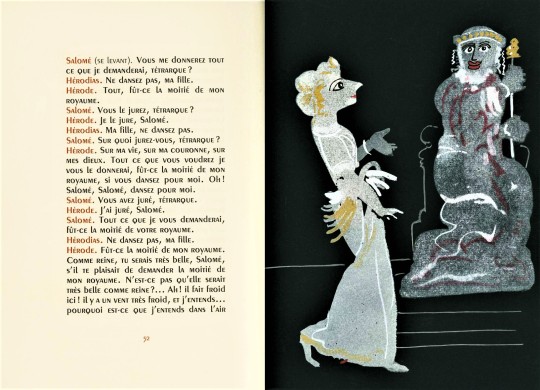
It was Beardsley himself who had first attempted to translate the play into English, but Wilde disapproved of the translation and refused to permit its publication. Ultimately, Wilde’s paramour, the poet Lord Alfred Douglas, translated the work, reportedly with extensive revisions by Wilde.
The play was immediately controversial in England for its depictions of biblical characters. The famous French actress Sarah Bernhardt was to play the titular role in the 1892 season at the Royal English Opera House. However, it was unlawful at that time to perform plays that were not approved by the Lord Chamberlain, and an interdiction against the portrayal of biblical characters on the stage halted rehearsals. The play was eventually produced in Paris in 1896, but Wilde never saw it performed. By that time, Wilde had been charged with sodomy and “gross indecency with men” and was sentenced to two years hard labor. Upon his release, Wilde returned to France and would never again set foot on British soil. He died, exiled and impoverished, three years later.
You can find more posts about Limited Editions Club here.
Explore more Staff Picks here.
-Olivia, Special Collections Graduate Intern
#Staff Pick of the Week#Salome#Oscar Wilde#Limited Editions Club#Aubrey Beardsley#The Fanfare Press#Ernest Ingram#fine press books#olivia
321 notes
·
View notes
Text
CC List For My Townies <3

From left to right: Sophia Tongol, Jared Cordero, Jana Bullock, Alexander Elkins
video here: https://youtu.be/LnWwZ5M2IuY
Sophia Tongol:
Skin Details:
- whimsy.berries rosemary skin (cannot find)
- https://miikocc.tumblr.com/post/653369415716519936/face-kit-no1
- https://sammi-xox.tumblr.com/post/695769342200201216/belly-overlay-n1-stuff-custom-thumbnail-10
- https://www.pinterest.com/pin/floral-a-skin-detail-cc-pack-by-peachyfaerie-in-2022--751749362812652277/
- Faeish Structure Merged
- https://www.thesimsresource.com/downloads/details/category/sims4-skintones/title/raina-skin-overlay-female/id/1451646/
Presets/Sliders:
- https://www.patreon.com/posts/25928157
- https://www.patreon.com/posts/eyebrow-slider-39393841
Tattoos:
- https://earthmoonz.tumblr.com/post/189630512051/luv-ya-babes-a-set-of-tattoos-technically-pt-3-of
- https://www.pinterest.com/pin/leafvy-gracias-a-mmfinds--758293656004101623/
Eyebrows:
- https://www.patreon.com/posts/gpme-gold-f-g12-31992546
Eyelashes:
- https://kijiko-catfood.com/3d-lashes-uncurled-eyelashes-edition/
Hair:
- https://simstrouble.tumblr.com/post/675996155756380160/tyler-by-simstrouble-base-game-compatible-24
Makeup:
- https://ppoyyopoyo.wixsite.com/pyopyosim/post/poyopoyo-eyelashes-n1-3-eye-contacts-n11
- https://www.tumblr.com/sims3melancholic/622193494913662976/download-ea-info-contacts-65-60
Clothes:
- https://www.patreon.com/posts/55848646
- https://www.patreon.com/posts/incheon-arrivals-67750031
Accessories:
- https://simstrouble.tumblr.com/post/667477937646338048/bruna-by-simstrouble-base-game-compatible-24
- https://www.thesimsresource.com/downloads/details/category/sims4-accessories-female-necklaces/title/cactus-necklace/id/1450226/
Shoes:
- https://arethabee.tumblr.com/post/669176529167745024/november2021
Jared Cordero:
Skin Details:
- https://faaeishccpreviews.tumblr.com/post/648642853067800576/skin-details-nose-shaders-by-faaeish-download
- https://lamatisse.tumblr.com/post/663592369391861760/mercuria
- https://sammi-xox.tumblr.com/post/689881262932082688/skindetail-dump-just-some-skindetails-from
- https://squeamishsims.tumblr.com/post/633692177214652416/moomoo-blush-by-squeamishsims-im-not-rlly-feeling
- https://okruee.tumblr.com/post/694208998289948672/misc-face-details-originally-meant-to-make-a
- Faeish Structure Merged
Presets/ Sliders:
- https://www.patreon.com/posts/eyebrow-slider-39393841
Tattoos:
- https://www.thesimsresource.com/downloads/details/category/sims4-accessories-male-tattoos/title/stay-wild-full-body-tattoo/id/1482613/
Eyebrows:
- https://www.patreon.com/posts/gpme-gold-f-g12-31992546
Eyelashes:
- https://kijiko-catfood.com/3d-lashes-uncurled-eyelashes-edition/
Facial Hair:
- https://introsims.tumblr.com/post/660842344000684032/intro-beard-10-male-young-adults-elders
Hair:
- https://johnnysimmer.tumblr.com/post/694028186546241536/michael-hair-new-promo-art-design-who-dis-info
Makeup:
- https://lamatisse.tumblr.com/post/705636235410046976/tapioca-default-nondefault-eyes-i-always-found
- https://www.tumblr.com/sims3melancholic/622193494913662976/download-ea-info-contacts-65-60
Clothes:
- https://arethabee.tumblr.com/post/654435314691145728/socasualcollection
- https://aharris00britney.tumblr.com/post/663949332951842816/planet-axa
Shoes:
- https://mmsims.tumblr.com/post/673366594684076032/s4cc-mmsims-dunk-low-sneakers
Jana Bullock:
Skin Details:
- https://okruee.tumblr.com/post/694208998289948672/misc-face-details-originally-meant-to-make-a
- https://obscurus-sims.tumblr.com/post/162047969368/skin-n1-overlay-3-swatches-teen-females-only
- https://miikocc.tumblr.com/post/653369415716519936/face-kit-no1
- https://squeamishsims.tumblr.com/post/633692177214652416/moomoo-blush-by-squeamishsims-im-not-rlly-feeling
- https://sayasims-cc.tumblr.com/post/682386301134274560/saya-sigr%C3%BAn-skin-overlay
Presets/ Sliders:
- https://stretchskeleton.tumblr.com/post/187172222703/some-mouth-presets-that-i-havent-posted-yet
- https://www.patreon.com/posts/eyebrow-slider-39393841
Eyebrows:
- https://www.thesimsresource.com/downloads/details/category/sims4-hair-facial-eyebrows/title/eyebrows-30/id/1472024/
Eyelashes:
- https://www.patreon.com/posts/3d-eyelashes-68587728
Hair:
- https://okruee.tumblr.com/post/695574171820900352/romy-hair-slay-info-17831-polys-bgc-hat
Makeup:
- https://www.tumblr.com/sims3melancholic/622193494913662976/download-ea-info-contacts-65-60
-https://www.thesimsresource.com/downloads/details/category/sims4-makeup-female-eyeliner/title/winged-smoky-eyeliner-n11/id/1307391/
- https://ppoyyopoyo.wixsite.com/pyopyosim/post/poyopoyo-eyelashes-n1-3-eye-contacts-n11
Clothes:
- https://sentate.tumblr.com/post/635394993993990144/sentate-x-trillyke-2020-trillyke-and-i-have-come
Accessories:
- https://www.thesimsresource.com/downloads/details/category/sims4-clothing-female-teenadultelder-everyday/title/trillyke-run-away-socks/id/1469854/
- https://arethabee.tumblr.com/post/654435314691145728/socasualcollection
Shoes:
- https://jius-sims.tumblr.com/post/676168239204712448/boots-collection-03-jius-leather-ankle-boots
Alexander Elkins:
Skin Details:
- https://okruee.tumblr.com/post/694208998289948672/misc-face-details-originally-meant-to-make-a
- Faeish Structure Merged
- https://miikocc.tumblr.com/post/653369415716519936/face-kit-no1
- https://sammi-xox.tumblr.com/post/688321643964186624/saturnine-skinblend-stuff-for-all-ages-genders
- https://sammi-xox.tumblr.com/post/689881262932082688/skindetail-dump-just-some-skindetails-from
- https://miikocc.tumblr.com/post/653369415716519936/face-kit-no1
- https://squeamishsims.tumblr.com/post/633692177214652416/moomoo-blush-by-squeamishsims-im-not-rlly-feeling
- https://simandy.tumblr.com/post/630272666330415104/because-every-time-i-look-at-photoshop-i-want-to
Presets/ Sliders:
- https://www.patreon.com/posts/eyebrow-slider-39393841
Eyebrows:
- https://obscurus-sims.tumblr.com/post/619679854568292352/eyebrows-n-30-33-colors-teen-female-only
Eyelashes:
- https://kijiko-catfood.com/3d-lashes-uncurled-eyelashes-edition/
Hair:
- https://simstrouble.tumblr.com/post/189809040505/jazzriff-hairstyle
Makeup:
- https://lamatisse.tumblr.com/post/705636235410046976/tapioca-default-nondefault-eyes-i-always-found
- https://www.tumblr.com/goppolsme/189529101062/gpme-gold-eyes-g16-download-at-goppolsme-patreon
- https://obscurus-sims.tumblr.com/post/174533730818/obscurusxmelancholic-collaboration-dl-video
Clothes:
- https://www.patreon.com/posts/euphoria-cc-pack-59513334
- https://gorillax3sims4.blogspot.com/2020/11/short-sleeve-shirt.html
Accessories:
- https://www.thesimsresource.com/downloads/details/category/sims4-accessories-female-earrings/title/piercing-set-n16/id/1382712/
Shoes:
- https://www.pinterest.com/pin/555631672759744306/
#TheSims#thesims4#the sims 4#the sims cc#the sims 4 cc#TS4#ts4cc#ts4 cc#ts4mm#TS4CAS#the sims 4 custom clothes#sims 4 custom content#custom content#sims4#sims#sims 4
26 notes
·
View notes
Text

Art: Salvador Dali, Repentant Penitent
* * * *
As a neurosis starts from a fragmentary state of human consciousness, it can only be cured by an approximative totality of the human being.
- C.G. Jung, Letter to Father David: 11 February 1961, C.G. Jung Letters 1951-1961 (Routledge 2015), Vol. 2, p. 625.
When the baby sees the mother as unhappy, it feels guilty. "I must have bit too hard. I damaged her with my teeth. That's why she looks so sad." We're dealing with the stage of oral aggression. Then, in the same period, the baby gets enraged – it's hungry, and has a temper tantrum. What does the mother do? She cuddles and caresses the baby. Thereby she erotically seduces it. This happens in all normal healthy development. Every normal baby has somehow gotten into a pattern of mutual seduction with mama. An extreme example that I sometimes use in teaching: The baby says, "Ah, to make Mother happy, l'll behave like a zombie." This begins the normal split between the Transcendental-Ego, and the Body-Ego whose dynamisms are thereby inhibited and repressed. The Transcendental-Ego, hitherto in communion with the Primordial Other, thus becomes the seductive and manipulative mind of what I call the "foxy baby," which replaces the "baby killer"; that is, violent aggression gets mentally-spiritually sublimated. But it is then normally lost to consciousness, to become the schizoid ego. This operates in a hidden chamber in the back of the mind that says, "Ain't I smart! I know that if I behave like a zombie, I'll make mother happy." Somewhere in the back of the minds of all who join up in collective movements or who take up prevailing fads, there's the hidden thought, "Ain't I smart. I know how to make myself popular or socially acceptable." The hidden schizoid ego usually shows up in dreams where the dreamer is amazed to discover a hitherto concealed room or closet in his or her own home. Be it noted that the schizoid ego is a normal, inevitable aspect of human life.
- Henry Elkin and E. Mark Stern, Toward a Freud-Jung Reconciliation: An Interview. In Carl Jung and Soul Psychology, edited by Donald Lathrop, Mark Stern, and Karen Gibson (Routledge, 1991), p. 123.
What at first looks like an abstract idea stands in reality for something that exists and can be experienced, that demonstrates its a priori presence spontaneously. Wholeness is thus an objective factor that confronts the subject independently of him.
- C.G. Jung, The Self, CW 9ii: Aion: Researches into the Phenomenology of the Self, par. 59.
[Analytical Psychology: Theory and Practice]
9 notes
·
View notes
Text

Kimberly Cullum and Mimi Rogers in The Rapture (Michael Tolkin, 1991)
Cast: Mimi Rogers, David Duchovny, Patrick Bauchau, Darwyn Carson, James Le Gros, Will Patton, Carole Davis, Sam Vlahos, Stéphanie Menuez, Marvin Elkins. Screenplay: Michael Tolkin. Cinematography: Bojan Bazelli. Production design: Robin Standifer. Film editing: Suzanne Fenn. Music: Thomas Newman.
European filmmakers are less skittish about dealing with religious belief than Americans are: Think of the three B's, Bergman, Buñuel, and Bresson, for example. But apart from biblical epics, which we don't see much of anymore, American movies usually avoid putting characters in situations that test their faith. Michael Tolkin's The Rapture is such an obvious exception to the rule that I think it has been a bit overpraised as a result. It succeeds as much as it does on the strength of Mimi Rogers's performance as Sharon, a woman whose life is empty: She works in a grindingly routine job as a telephone operator and escapes from it by going out at night with a friend, Vic (Patrick Bauchau), picking up other couples for sex. She begins a relationship with Randy (David Duchovny), the male half of one of the couples they meet, but remains as bored and depressed as ever. At work she overhears people talking about a religious group to which they belong, and how good it makes them feel, so she investigates and soon becomes a devout member of a sect that believes the Rapture is at hand, that the end of the world is nigh and the true believers will be transported directly to Heaven. She finds comfort in the belief, converts Randy to it, and they marry and have a child, only to face a real crisis of belief. Up to this point, The Rapture is a solid and mostly convincing portrayal of the way religious belief can sometimes become a last resort. Unfortunately, Tolkin chose to end the film with a low-rent Apocalypse that tests the movie's budget and the audience's credulity as much as it does Sharon's faith.
2 notes
·
View notes
Photo
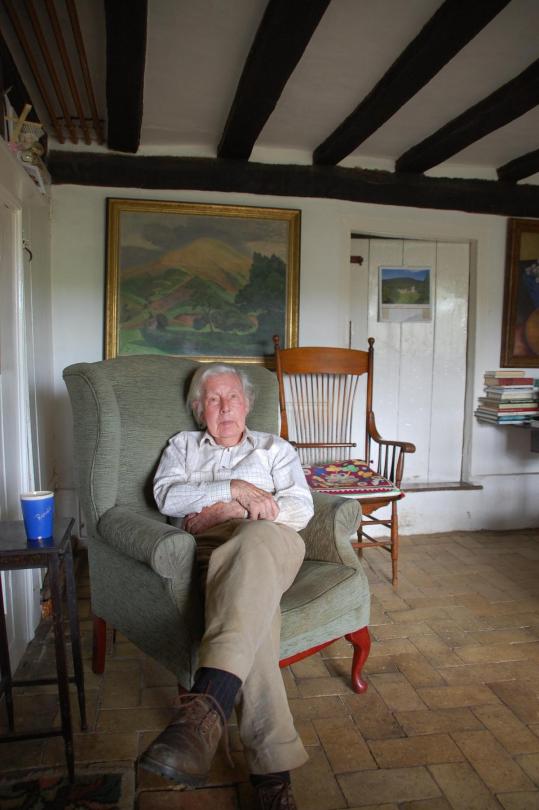
In the summer of 1967, Ronald Blythe cycled from his home in the Suffolk hamlet of Debach to the neighbouring village of Charsfield. There he listened to the voices of blacksmiths, gravediggers, nurses, horsemen and pig farmers. He gave them names from gravestones and placed them in a fictional village. Akenfield, a portrait of a rural life rapidly disappearing from view, was immediately acclaimed as a classic when it was published in 1969.
Never out of print and read and studied around the world, Akenfield made Blythe famous and perhaps overshadowed the many other fruits of his long years of writing – short stories, poems, histories, novels and, in later life, luminous essays and a superb weekly diary that the Church Times published for 25 years until 2017. Blythe, who has died aged 100, is regarded by his peers and many readers as the finest contemporary writer on the English countryside.
The eldest of six children, Blythe was born in Acton, near Lavenham, into a family of farm labourers rooted in rural Suffolk. His surname comes from the Blyth, a small Suffolk river, but his mother and her family were Londoners. His mother, Matilda (nee Elkins), a nurse, passed to him her love of books. Although Blythe left school at 14, by then he had already established a voracious reading habit – “never indoors, where one might be given something to do,” he remembered – which became his education.
His father, Albert, had served in the Suffolk Regiment and fought at Gallipoli and Blythe was conscripted during the second world war. Early on in his training, his superiors decided he was unfit for service – friends said he was incapable of hurting a fly – and he returned to East Anglia to work, quietly, as a reference librarian in Colchester library.
He befriended local writers including the poet James Turner, who helped his passage into a bohemian, creative Suffolk circle that included Sir Cedric Morris, who taught Lucian Freud and Maggi Hambling and lived nearby with his partner, Arthur Lett-Haines. Blythe “longed to be a writer”, he said, and he listened and learned – inspired by the example of poet friends including Turner (the unnamed poet in Akenfield) and WR Rodgers of how to live with very little money. “It was a kind of apprenticeship,” he once recalled.
Most importantly, in 1951 he met the artist Christine Kühlenthal, wife of the painter John Nash. Kühlenthal encouraged his writing and championed him: Blythe edited Aldeburgh festival programmes for Benjamin Britten and even ran errands for EM Forster, who took a shine to the shy young man. Blythe helped Forster compile an index for Forster’s 1956 biography of his great-aunt, Marianne Thornton.
Blythe’s first, Forster-inspired novel, A Treasonable Growth, was published in 1960. He followed it in 1963 with The Age of Illusion, a social history of life in England between the wars. He earned money from journalism, being a publishers’ “reader” and editing a series of classics – including one of his heroes, the essayist William Hazlitt – for the Penguin English Library.
After a stint living in Aldeburgh, recalled in an elegiac and characteristically discreet memoir, The Time by the Sea (2013), he moved to a cottage in Debach. In the mid-1960s, he was befriended by the American novelist Patricia Highsmith. “I admired her enormously. She was a very strange, mysterious woman. She was lesbian but at the same time she found men’s bodies beautiful,” he remembered. One evening, after a Paris literary do, they slept together; he told a friend they were both curious “to see how the other half did it”.
Blythe said the idea for Akenfield (he took the name from the old English “acen” for acorn) arrived as he tramped the Suffolk fields pondering the anonymity of most farm labourers’ lives. His friend Richard Mabey remembers it being commissioned by Viking as the lead title for a short-lived series on village life around the world.
Over 1967 and 1968, he listened to the citizens of Charsfield, recreating authentic country voices while somehow adding a poetry of his own. The result was a portrait of the “glory and bitterness” of the countryside: the penury and yet deep pride of the old, near-feudal farming life, and its obliteration in the 60s by a second agricultural revolution alongside the arrival of the car and television.
The village voices were never sentimental about country life, and nor was Blythe: as well as stories of how to make corn dollies, there were quiet revelations of incest, and the district nurse recounted the old days when old people were stuffed into cupboards. Old labourers remembered the “meanness” of farmers who had treated their workers like machines because the big rural families delivered a seemingly endless supply of farm-fodder.
Ecstatic reviews of this “exceptional” and “delectable” book in Britain spread to North America, where Time praised it, John Updike loved it and Paul Newman wanted to film it. But some oral historians were suspicious that Blythe had not recorded his conversations.
Blythe turned down a film offer from the BBC but eventually accepted a pitch from the theatre director Peter Hall, a fellow Suffolk man. Blythe wrote a new synopsis inspired by the unfilmable book, and Hall asked ordinary rural people to improvise scenes with no script. Blythe oversaw every day of filming and played an apt cameo as a vicar. Nearly 15 million people watched Akenfield when it was broadcast on London Weekend Television in early 1975.
Blythe’s next book, The View in Winter (1979), was a prescient examination of old age in a society that did not value it, at a time when more people than ever reached it. The “disaster” suffered by the old, he wrote, is “nobody sees them any more as they see themselves”. Blythe regarded it as his best book. While he was writing it, Kühlenthal died, and Blythe moved into the Nashes’ old farm, Bottengoms, to look after the elderly Nash. When Nash died a year later, he left the house to Blythe. There Blythe lived for the rest of his life, writing beautifully about his home in At the Yeoman’s House (2011).
In later years, Blythe drew praise for his short stories and essays, including a series of meditations on the 19th-century rural poet John Clare. Many writers who were later grouped together as “nature writers” became his friends, including Mabey, Robert Macfarlane and Roger Deakin.
Blythe never married, never lived with anyone, and kept his personal life veiled. Interviewed by the Observer in November 1969, he was judged “intensely private”. He disclosed nothing in his published writing about his love affairs with men, or indeed his one-night stand with Highsmith.
He was almost as reticent about his faith, but his writing was deeply suffused in his Christian beliefs and his knowledge of the scriptures. He was a lay reader – deputising for vicars across several parishes – and became a lay canon of St Edmundsbury Cathedral, but turned down the chance to become a priest.
Rowan Williams, the former archbishop of Canterbury and an admirer of Blythe’s writing, believed Blythe used the Christian year of festivals as “a steady backdrop” for his writing and thinking, which was liberated by his faith. The writer Ian Collins, a good friend of Blythe in his later years, felt it was Blythe’s lack of formal education or “training” that liberated his original thinking and elegant prose style.
Blythe was politically radical throughout his life, a Labour voter who joined peace vigils outside St-Martin-in-the-Fields in London. Friends were surprised when he accepted a CBE in 2017, around the time he was gently “retired” from public speaking and writing as his short-term memory faded. When he reached 100, he was still well enough to sign 1,500 copies of a new compilation of his best Church Times columns.
The old people who thrived in The View in Winter were those, Blythe concluded, who were able to preserve their “spiritual vitality, a vividness, an imaginative sort of energy”. This credo served him well as he grew older, although he was mistaken in another respect. The old, he wrote, are “cared for, surrounded with kindliness, and people are often interested in what they say; but they are not truly loved and they know it”.
Blythe was much loved in later life. A roster of devoted friends he called his “dear ones” visited him daily, supplied him with hot meals and ensured he could live out his years at Bottengoms.
🔔 Ronald George Blythe, writer, born 6 November 1922; died 14 January 2023
Daily inspiration. Discover more photos at http://justforbooks.tumblr.com
14 notes
·
View notes
Text
WTNV quick rundown - 51 - Rumbling
Hello! Welcome back! Nice to see you again : ) Featuring Dylan Marron as Carlos the Scientist.
Look! Up in the sky. It's a bird. It's a plane. It's a cloud. It's a moon. Also, some stars. There are so many things in the sky. Welcome to Night Vale.
Carlos is still in the Desert Otherworld, but calls in bursts to talk to Cecil. Carlos is very excited by the otherworld and it's many mysteries. He tells Cecil that it's his duty as a scientist to discover why and how these things are.
Things like what is making the great rumbling in the desert. For most of the episode, Cecil cannot hear the rumbling that Carlos mentions, until it finally crosses over into NV. Carlos reports he has found a patch of red mud which contains several bones of unknown origin, that the red blinking light on the mountains lighthouse holds steady when the rumbling happens and that the ground seems to bulge when the rumbling happens.*
He is almost crushed by falling boulders during one of these rumblings, but Doug (the assumed leader of the giant masked warriors) saves him. He also breaks his phone, but it miraculously 'heals' itself (as well as having 3-bar 4G and 97% battery as it did when he entered the otherworld).
Cecil urges him to try and find a door back, but Carlos says that he needs to do the science first. Still, he assures Cecil that he loves him very much and is happy they can still talk to each other. Reluctantly, Cecil resigns to the understanding that this is important to Carlos and he must be patient about Carlos' return.
Carlos: But I do know two things.
Cecil: What's that?
Carlos: I love you.
Cecil: I love you too. What's the other thing?
Carlos: You just said it.
Weather: "Echo in the Hills" by Carrie Elkin and Danny Schmidt carrieelkin.com and dannyschmidt.com
Dana attempted to open up the dog park to everyone, but was taken away by City Council and returned wearing several large ivory rings and a cerulean cape to retract her statement and announce more security measures around the dog park.
Cecil is happy that Station Management is back, even if walking past their office causes him to crumble to the floor, struck numb and blind with flashes of hideous daydreams, a history’s worth of deaths that were not his own. They have also apparently managed the station 'for centuries'.
Desert Bluffs ran a full-page ad in the Sunday extra-large imagination edition of the Night Vale Daily Journal that said, (apparently, because it's all 'imagined'), "Thank you for having us, Night Vale. Best of luck in your future."
Cecil can't tell if it ends in an exclamation point or a question mark because of the 'weird font'. It's like someone put paint or some other thick liquid on the tip of a sharp finger and then handwrote this ad.
At the bottom, it has a photo of 'your' face and the same finger painted lettering that reads "Blessings from a Smiling God". The photo is apparently a good one of 'you', whilst you're sleeping which makes 'you' look 'adorable'.
The Erika's, despite still being ignored as the angels they are, are well under way constructing something new out of the old Strex headquarters on the lip of Radon Canyon.
During the horoscopes, Scorpio's starts off nice for once, before fakely going back to being mean but not with the same venom as before. Since we know this is Cecil's outlet of hatred towards Steve Carlsberg, we can see their changing relationship there.
The earthquake that the rumbling causes in NV caused 'quite a bit' of structural damage and knocked out a third of the towns power but did not register on the Richter scale somehow.
Stay tuned next for the sound of future becoming the present becoming the past in no time at all. And as always, good night, Night Vale. Good night.
Proverb: Everything that happens happens for a reason. Except ostriches. What the hell, man?
*the activity we see described here is not fully explained until the It Devours! novel in which we discover that there is a giant centipede living under the desert which periodically emerges to feed.
9 notes
·
View notes
Text
In an effort to keep myself sane in what’s clearly gonna be a series of John episodes I’m (mostly) condensing my John rage to one post. Just ignore me I’ve gotta get it out somewhere.
Every time I think I must be being too hard on John he makes the mistake of showing up on screen and I have to dig a deeper hole to bury my expectations for him
John: I need your help finding an incredibly dangerous magical gun.
Dean and Sam: Cool. Mind telling us it’s special powers so we know what to look out for:
John: No.
—
Okay I know this is the men refusing to communicate show, but even by spn standards John’s categorical refusal to give his sons basic information relevant to cases and their baseline survival is genuinely starting to feel pathological at this point.
At first I thought I was just being mean and petty by theorizing that it was a control tactic to keep them dependent on him, but I’m struggling to see any other explanation at this point.
Edit: Okay having watched the whole episode I suppose he’d say that absolute unquestioning obedience is the best guarantor of safety. If I put in the work of remembering that John was in the army I can dredge up some empathy through recognizing that this thinking was no doubt aggressively drilled into him.
That being said, that kinda authoritarian thinking does SO much damage wherever it’s found, and when it’s coming from a parent? Yikes. And it cannot continue to function without a high degree of arrogance, self-aggrandizing, and tearing down of those ‘under’ you (all of which we see John engaging in constantly). In John’s case it also requires a certain fundamental lack of curiosity and refusal to learn when the results are constantly exposing the fundamental flaws in the approach.
—
I will fully own that I’m being petty with this, but: I would like to observe that after however long searching for a way to kill the yellow-eyed demon, when John finds out about the colt it is %100 disconnected from any of the research he insists he’s doing. He pulled a letter found by his sons out of their hands and by pure chance it says ‘go here for the kill everything gun’.
Wait now I say that out loud I stand by it, that’s a solid point in the ‘John is a shit hunter who builds up his own legend by belittling his sons and taking credit for their accomplishments column.’
Here’s the petty part: maybe if John was capable of maintaining any relationship at all Elkins would have just told him about the gun instead of John having to wait all these years to learn about it by accident (through his sons being smart and good at their jobs).
—
Credit where it is due. I was pleasantly surprised by John’s talk with Sam about why he raised them that way and why he responded so horrifically to Sam leaving for college. There’s plenty I take issue with in the particulars of the speech, but when push comes to shove that was a lot closer to an apology and involved something a whole lot closer to genuine introspection than I expected.
He’s given enough reason to distrust him that I do think it may (at least in part) be a manipulation tactic; placating Sam so he’ll stick around until John’s had use of him. But I would like Sam to have that catharsis and will give John the benefit of the doubt unless he forces me to rescind it.
—
However, just in case I was considering softening towards John, the first thing he does after being nice to Sam for five seconds is use Dean as bait. I would like to observe that this is the first possible opportunity John has had during the show for using Dean as bait on a hunt and he is TAKING it.
—
I would like to note that John shows 0 interest in saving the vampire’s captives at any point of this episode. I mean he’d likely have gotten around it to (assuming he’d noticed they were there) but I don’t actually have any concrete reason to assume that without once again giving him the benefit of the doubt when he’s done nothing to earn it. Funny that
—
Minimal credit time part 2: This time when his son’s save his life John actually admits it instead of making them feel like it was was their fault he was in trouble in the first place. And look, going back to the authoritarianism thing, admitting that their disobeying an order had a positive effect, even going so far as to change his mind about his insistence on going it alone that he’s been so didactic about really does seem like a big deal to him, and as infuriating as his behavior has been this episode, taken by itself this episode really looks like it could be a turning point towards John learning to be a better father and building a more positive relationship with his sons.
Like really truly I like when characters learn and grow and I think it’d be awesome if Sam and Dean’s relationship with their father improved. If I hadn’t spent so much time in Supernatural I really think I’d be holding out a bit of hope for this man right now.
Unfortunately for my optimism on this point I have spent so much time on Supernatural tumblr
—
I have Thoughts about John’s relentless “it’s because I care about you” excuse for every action he takes. However they are still formulating and I have a funny feeling that it’s gonna keep coming up in the next two episodes, so I’ll let those simmer for now.
2 notes
·
View notes
Quote
The photograph necessarily shows what was in front of the camera; the painting only shows what was in front of the canvas optionally--and the option is the painter's.
Barthes makes this point by saying, "Painting can feign reality without having seen it"; Kendall Walton makes it by saying, "Photographs are counterfactually dependent on the photographed scene even if the beliefs (and other intentional attitudes) of the photographer are held fixed". His point is that paintings are "based on the beliefs" (again, or other intentional attitudes) "of their maker", photographs are not.
Walter Benn Michaels / Photographs and Fossils in Photography Theory edited by James Elkins, 2006 / p. 434
#Roland Barthes#Walter Benn Michaels#photographs#photography#fossils#quote#quotes#painting#representation#indexicality#objectivity#subjectivity
3 notes
·
View notes
Text
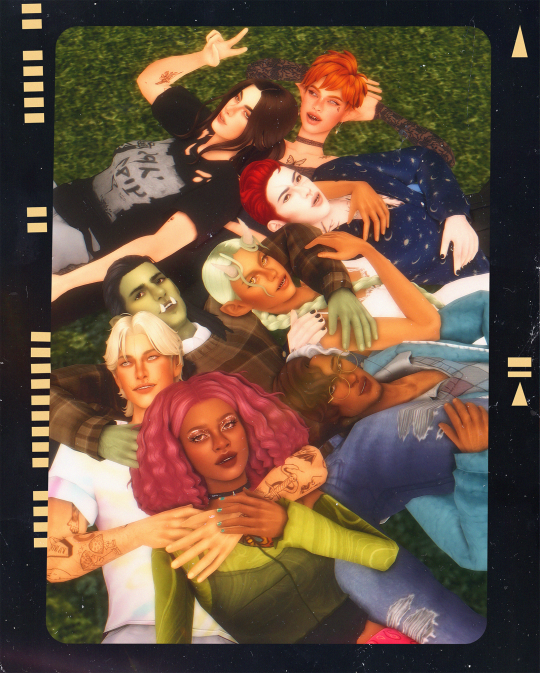
8 best friends in glimmerbrook... what will happen next...
#PREDICT WHO WILL FALL IN LOVE#i keep being like i hate this post and deleting it but whatever#ts4 edit#sims 4 edit#ts4#sims 4#sims 4 gameplay#ts4 gameplay#wm: supernatural save#my sims#sim: juniper burch#sim: weaver marsh#sim: julian greenwood#sim: delta elkins#sim: frankie burrows#sim: desmond fell#sim: merinda hemlock#sim: xavier thornton#wm: ts4#wm: ts4 gp
271 notes
·
View notes
Text
The Inseperables by Simone de Beavoir
A short novel telling the story of a friendship between two young girls, Sylvie and Andree, who meet at school in France. The edition I read is also accompanied by archive material, an introduction by Deborah Levy, a note from the translator of the story, Lauren Elkin, and an afterword by Sylvie Le Bon de Beauvoir. These writings and the archival material all confirm that Simone de Beaviour is writing about a real friendship that started in her childhood; she is Sylvie and Andrée is based on her friend, Elizabeth Lacoin.
What struck me most was Audrée’s transformation. At the beginning of the novel, as a child, she seems so bright, bold and fearless. But by the end, as she reaches her twenties, Audrée starts to lose this. Suffocated by the constraints of her circumstances, she becomes a danger to herself. This is a sharp and unapologetic turn away from the warm portrait of childhood that the book opens with. But when I think about it, there were signs that this shift was coming. The book is written from Sylvie’s perspective, and she casts Andrée in such a positive, sunshiny light, it is as though, by the time of writing, something had happened that moved her memory in this direction.
I loved the scene when the two girls meet, at the beginning of the book, in a class taught by Mademoiselle Dubois:
Mademoiselle Dubois came in, her long dress sweeping the floorboards. She was a lively, moustachioed woman whom I greatly respected. She sat down and called the register. When she reached Andree’s name, she asked:
‘Well my girl, I hope we’re not intimidating you?’
‘I am not timid, Mademoiselle,’ said Andrée with composure, adding, in a friendly voice, ‘anyway, you are not intimidating.’
Mademoiselle Dubois hesitated for a moment, then smiled under her moustache and carried on.
The book is filled with such beautiful images of the two girls at school together, their friendship and connection, how they managed to support each other, personally and academically, in ways unmatched by parents and teachers. Sylvie's acceptance of all of Audrée’s flaws – her aloofness and denial – is the foundation of their relationship, the reason it endures, and I think it’s the reason the story comes together in the way that it does.
3 notes
·
View notes
Photo





[Begin Image Description, from top to bottom.
Image 1: A nightclub with palm trees, large glass windows and doors and white walls
Image 2: A sim with long black hair in a small ponytail with a notifaction reading Attractiveness Alert! Wow, what a Sim! Gemma Stone just stopped what they were thinking about for a moment and found themselves staring at Garrett Elkins. That man has so many of the qualities that make Gemma's heart race, as if it were on a cross country marathon. Their handsom features meet Gemma's diesires so readily that it's almost as if whatever created such a Sim sculpted him perfectly for Gemma. Now the only thing left is to pick up their jaw and work up the courage to speak to such an Adonis. Hopefully, Garrett will be kind enough to reciprocate Gemma's feelings.
Image 3: A sim with curly brown hair in a bun talking to a sim with long black hair in a small ponytail with a smile
Image 4: A sim with curly brown hair in a bun looking at their phone
Image 5: A banner with a grey top part and a white bottom part, on the top part is the words Stone Legacy on the far left and on the bottom part is the words Gen 1 on the far right
End Image Description
Story and dialogue below cut:
After the coffehouse didn’t pan out, Gemma decides to head to the next best place to mingle: Club Llamante also in Maristella.
Gemma: *gasps*
What? What’s-oh, huh...
( Author’s Note: apologies for the blurry notification, I messed up editing it and saved over the original so I couldn’t go back and edit it)
Garrett: Why do I have the distinct feeling I’ve gotten myself into something?
Apparently, all Gemma needed to do was go to a nightclub to find her soulmate, who knew?
So of course, after she closed her mouth, Gemma went to introduce herself to her Adonis and they seemed to get along pretty well.
Garrett: Who’s talking?
Gemma: Just ignore her, I do.
Ha ha, want to see if you can get set on fire again?
Gemma: If I die, your legacy ends so you’re stuck with me.
*grumbles*
Eventually however, Gemma had work tommorow so with a heavy heart, we leave Garrett behind and-Gemma, texting while you’re walking, especially at night is a bad idea.
Gemma: How else am I supposed to show off the new feature EA gave us for no reason.
You got me there.
Beginning / Previous / Next
2 notes
·
View notes
Photo

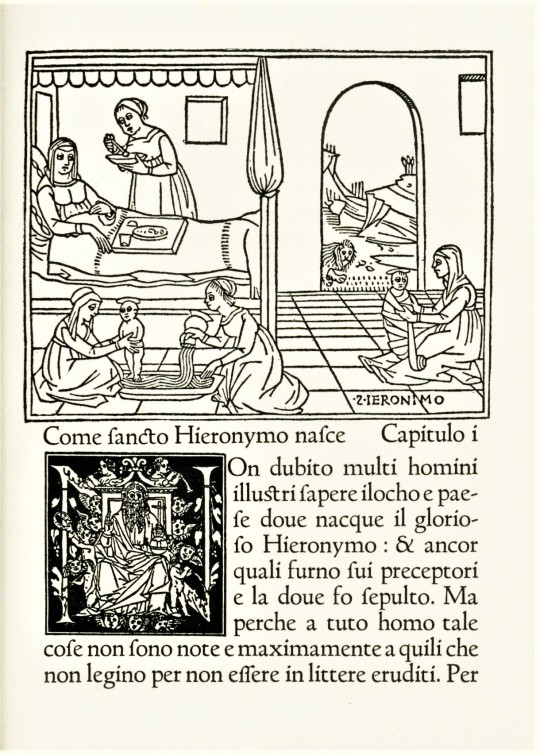







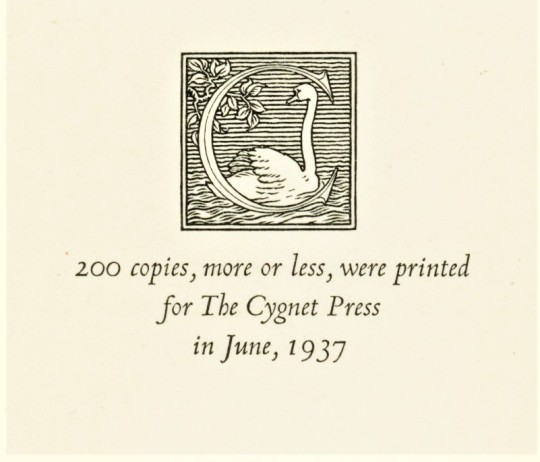
It’s Fine Press Friday!
On this first #Fine Press Friday of 2023, we present a couple of items from one of the more obscure 20th-century American private presses, the Cygnet Press of Cambridge, Massachusetts. Cygnet Press was founded in 1928 and co-managed by two Harvard academics, George Parker Winship (1871-1952) and Philip Hofer (1898-1984). Winship was the long-time curator for both the John Carter Brown Collection at Brown University and the Harry Elkins Widener Collection at Harvard University. Hofer had been curator for the Spencer Collection of the New York Public Library and assistant director of the Morgan Library before founding the Department of Printing and Graphic Arts at Harvard’s Houghton Library. Both librarians maintained a strong interest in fine press printing and printing history.
The first book off the press was a 1934 facsimile edition of Vita de Sancto Hieronymo (the first eight images), an Italian translation of the letters of St. Jerome by Matteo da Ferrara, originally printed in Ferrara by Lorenzo di Rossi da Valenza in 1497. In a 1934 letter that accompanied a different copy of this book, Hofer wrote: “The little book which accompanies this note is one which George Parker Winship and I set by hand and printed a few years ago. It amused us, and, I hope, will amuse you. Of course we would do it differently now - that is always the way!"
The last two images are from a very slim booklet entitled Tanatlus, the fourth imprint from the press, printed for friends in 1937 in an edition of 200 copies. The publication focuses on the color wood engraving of the punishment of the Greek mythological figure Tantalus. The engraving, by the master Czech American wood engraver, illustrator, and type and book designer Rudolph Ruzicka (1883-1978), was designed after a watercolor by Hans Holbein the Younger, “which the best woodcutter of Holbein’s time could not have bettered.”
The original watercolor, conjectured to have been intended as a jeweler’s design, had been acquired by someone in Winship’s and Hofer’s circle in 1936. Ruzicka made seven blocks printed in different colors and values “to make an almost perfect counterpart of the original . . . .” To explain the image, the Greek texts of Homer and Pindar and the Latin text of Horace, along with English translations, are printed as part of the booklet.
Our copies of these two publications are gifts from our friend Jerry Buff.
View more posts with work by Rudolph Ruzicka.
View more Fine Press Friday posts.
View more posts with wood engravings!
#Fine Press Friday#Fine Press Fridays#Cygnet Press#George Parker Winship#Philip Hofer#Rudolph Ruzicka#Harvard#Vita de Sancto Hieronymo#St. Jerome#Matteo da Ferrara#Tantalus#Hans Holbein the Younger#wood engravings#fine press books#private presses
38 notes
·
View notes